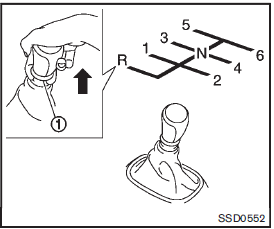Nissan Juke Owners Manual : Manual Transmission (MT)
WARNING
• Do not downshift abruptly on slippery roads. This may cause a loss of control.
• Do not over-rev the engine when shifting to a lower gear. This may cause a loss of control or engine damage.
• When the high fluid temperature protection mode or fail-safe operation occurs, vehicle speed may be gradually reduced. The reduced speed may be lower than other traffic, which could increase the chance of a collision. Be especially careful when driving. If necessary, pull to the side of the road at a safe place and allow the transmission to return to normal operation, or have it repaired if necessary.
CAUTION
• Do not rest your foot on the clutch pedal while driving. This may damage the clutch.
• Fully depress the clutch pedal before shifting to help prevent transmission damage.
• Stop your vehicle completely before shifting into R (Reverse).
• When the vehicle is stopped for a period of time, for example at a stop light, shift to N (Neutral) and release the clutch pedal with the foot brake applied.

Shifting
To change gears, or when upshifting or downshifting, fully depress the clutch pedal, shift into the appropriate gear, then slowly and smoothly release the clutch pedal.
Start the vehicle in 1st gear and shift to 2nd, 3rd, 4th, 5th and 6th gear in sequence according to vehicle speed.
To back up, pull the shift lever ring 1 upward and then move it to the R (Reverse) gear after stopping the vehicle completely.
The shift lever ring returns to its original position when the shift lever is moved to the N (Neutral) position.
If it is difficult to move the shift lever into the R (Reverse) or 1st gear, shift to the N (Neutral) position, and then release the clutch pedal once.
Fully depress the clutch pedal again and shift into the R (Reverse) or 1st gear.
Suggested upshift speeds
The following are suggested vehicle speeds for shifting into a higher gear. These suggestions relate to fuel economy and vehicle performance.
Actual upshift speeds will vary according to road conditions, the weather and individual driving habits.
Gear change MPH (km/h)
1st to 2nd
15 (24)
2nd to 3rd
25 (40)
3rd to 4th
40 (64)
4th to 5th
45 (72)
5th to 6th
50 (80)
Suggested maximum speed in each gear Downshift to a lower gear if the engine is not running smoothly, or if you need to accelerate.
Do not exceed the maximum suggested speed (shown below) in any gear. For level road driving, use the highest gear suggested for that speed. Always observe posted speed limits, and drive according to the road conditions, which will ensure safe operation. Do not over-rev the engine when shifting to a lower gear as it may cause engine damage or loss of vehicle control.
Gear
MPH (km/h)
1st
33 (53)
2nd
57 (92)
3rd
79 (127)
4th
—
5th
—
6th
—
 Continuously Variable Transmission (CVT)
Continuously Variable Transmission (CVT)
The Continuously Variable Transmission (CVT) in your vehicle is electronically
controlled to produce maximum power and smooth operation.
The recommended operating procedures for this transmission a ...
 Integrated control system (if so equipped)
Integrated control system (if so equipped)
The Integrated Control System is located below the audio system or navigation
system (if so equipped). Two Integrated Control System modes can be selected: Drive
mode and Climate Control mode.
De ...
Other materials:
Security indicator lamp does not turn on or blink
Description
Security indicator lamp does not blink when ignition switch is in a position
other than ON.
NOTE:
• Before performing the diagnosis, check “Work Flow”. Refer to SEC-47, "Work
Flow".
• Check that vehicle is under the condition shown in “CONDITIONS OF VEHICLE
(OPERATI ...
S terminal circuit
Description
The starter motor magnetic switch is supplied with power when the ignition
switch is turned to the START position
while the selector lever is in the P or N position for CVT models or the clutch
pedal is depressed for M/T
models.
Diagnosis Procedure
CAUTION:
Perform diagnosis un ...
Lubricant
Description
MAINTENANCE OF LUBRICANT LEVEL
The compressor lubricant is circulating in the system together with the
refrigerant. It is necessary to fill compressor
with lubricant when replacing A/C system parts or when a large amount of
refrigerant leakage is
detected. It is important to alwa ...
